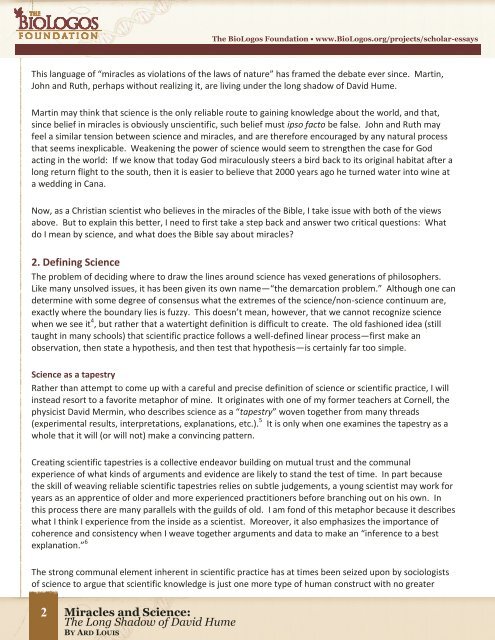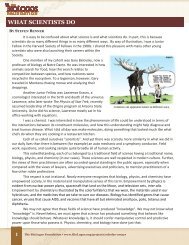Miracles and Science: The Long Shadow of David Hume - BioLogos
Miracles and Science: The Long Shadow of David Hume - BioLogos
Miracles and Science: The Long Shadow of David Hume - BioLogos
Create successful ePaper yourself
Turn your PDF publications into a flip-book with our unique Google optimized e-Paper software.
<strong>The</strong> <strong>BioLogos</strong> Foundation • www.<strong>BioLogos</strong>.org/projects/scholar-essays<br />
This language <strong>of</strong> “miracles as violations <strong>of</strong> the laws <strong>of</strong> nature” has framed the debate ever since. Martin,<br />
John <strong>and</strong> Ruth, perhaps without realizing it, are living under the long shadow <strong>of</strong> <strong>David</strong> <strong>Hume</strong>.<br />
Martin may think that science is the only reliable route to gaining knowledge about the world, <strong>and</strong> that,<br />
since belief in miracles is obviously unscientific, such belief must ipso facto be false. John <strong>and</strong> Ruth may<br />
feel a similar tension between science <strong>and</strong> miracles, <strong>and</strong> are therefore encouraged by any natural process<br />
that seems inexplicable. Weakening the power <strong>of</strong> science would seem to strengthen the case for God<br />
acting in the world: If we know that today God miraculously steers a bird back to its original habitat after a<br />
long return flight to the south, then it is easier to believe that 2000 years ago he turned water into wine at<br />
a wedding in Cana.<br />
Now, as a Christian scientist who believes in the miracles <strong>of</strong> the Bible, I take issue with both <strong>of</strong> the views<br />
above. But to explain this better, I need to first take a step back <strong>and</strong> answer two critical questions: What<br />
do I mean by science, <strong>and</strong> what does the Bible say about miracles<br />
2. Defining <strong>Science</strong><br />
<strong>The</strong> problem <strong>of</strong> deciding where to draw the lines around science has vexed generations <strong>of</strong> philosophers.<br />
Like many unsolved issues, it has been given its own name—“the demarcation problem.” Although one can<br />
determine with some degree <strong>of</strong> consensus what the extremes <strong>of</strong> the science/non-science continuum are,<br />
exactly where the boundary lies is fuzzy. This doesn’t mean, however, that we cannot recognize science<br />
when we see it 4 , but rather that a watertight definition is difficult to create. <strong>The</strong> old fashioned idea (still<br />
taught in many schools) that scientific practice follows a well-defined linear process—first make an<br />
observation, then state a hypothesis, <strong>and</strong> then test that hypothesis—is certainly far too simple.<br />
<strong>Science</strong> as a tapestry<br />
Rather than attempt to come up with a careful <strong>and</strong> precise definition <strong>of</strong> science or scientific practice, I will<br />
instead resort to a favorite metaphor <strong>of</strong> mine. It originates with one <strong>of</strong> my former teachers at Cornell, the<br />
physicist <strong>David</strong> Mermin, who describes science as a “tapestry” woven together from many threads<br />
(experimental results, interpretations, explanations, etc.). 5 It is only when one examines the tapestry as a<br />
whole that it will (or will not) make a convincing pattern.<br />
Creating scientific tapestries is a collective endeavor building on mutual trust <strong>and</strong> the communal<br />
experience <strong>of</strong> what kinds <strong>of</strong> arguments <strong>and</strong> evidence are likely to st<strong>and</strong> the test <strong>of</strong> time. In part because<br />
the skill <strong>of</strong> weaving reliable scientific tapestries relies on subtle judgements, a young scientist may work for<br />
years as an apprentice <strong>of</strong> older <strong>and</strong> more experienced practitioners before branching out on his own. In<br />
this process there are many parallels with the guilds <strong>of</strong> old. I am fond <strong>of</strong> this metaphor because it describes<br />
what I think I experience from the inside as a scientist. Moreover, it also emphasizes the importance <strong>of</strong><br />
coherence <strong>and</strong> consistency when I weave together arguments <strong>and</strong> data to make an “inference to a best<br />
explanation.” 6<br />
<strong>The</strong> strong communal element inherent in scientific practice has at times been seized upon by sociologists<br />
<strong>of</strong> science to argue that scientific knowledge is just one more type <strong>of</strong> human construct with no greater<br />
2<br />
<strong>Miracles</strong> <strong>and</strong> <strong>Science</strong>:<br />
<strong>The</strong> <strong>Long</strong> <strong>Shadow</strong> <strong>of</strong> <strong>David</strong> <strong>Hume</strong><br />
BY ARD LOUIS




